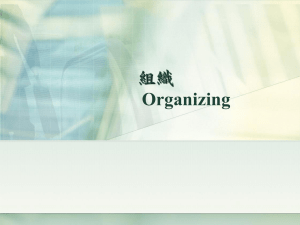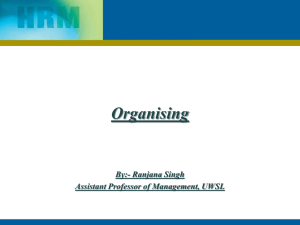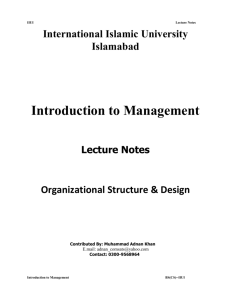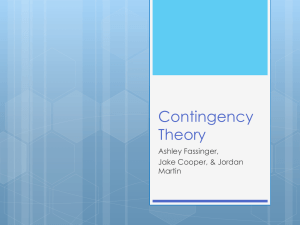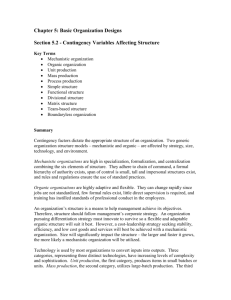Chapter One Managers and Management
advertisement
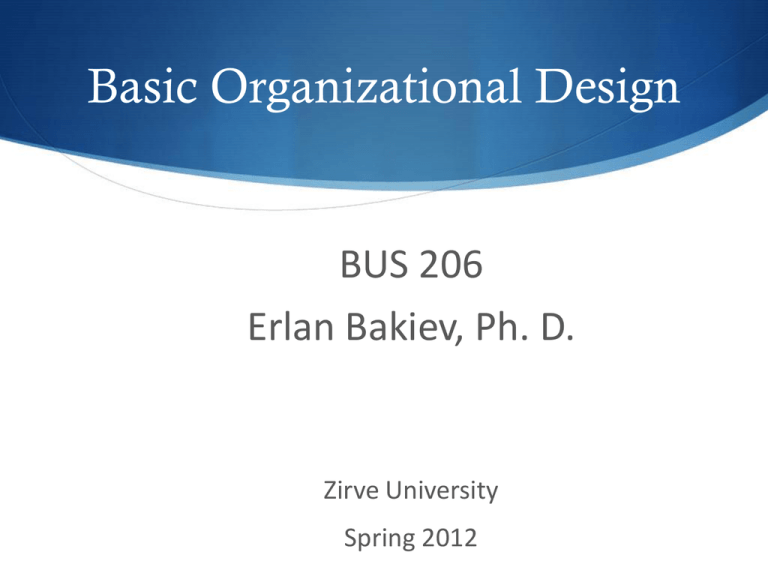
Basic Organizational Design BUS 206 Erlan Bakiev, Ph. D. Zirve University Spring 2012 Basic Organizational Design •Describe six key elements in organizational design •Contrast mechanistic and organic structures •Discuss the contingency factors that favor either the mechanistic model or the organic model of organizational design •Describe traditional organizational designs Designing Organizational Structure Organizing - arranging and structuring work to accomplish an organization’s goals. Organizational Structure - the formal arrangement of jobs within an organization. Organizational Design - a process involving decisions about six key elements: Work specialization Departmentalization Chain of command Span of control Centralization and decentralization Formalization Exhibit 10-1: Purposes of Organizing Organizational Structure Work Specialization The degree to which tasks in the organization are divided into separate jobs with each step completed by a different person. Overspecialization can result in human diseconomies such as boredom, fatigue, stress, poor quality, increased absenteeism, and higher turnover. Exhibit 10-2: Economies and Diseconomies of Work Specialization Departmentalization by Type Functional Grouping jobs by functions Grouping jobs on the basis of performed Product Grouping jobs by product line Process product or customer flow Customer Grouping jobs by type of customer and needs Geographical Grouping jobs on the basis of territory or geography Organizational Structure (cont.) Chain of Command - the continuous line of authority that extends from upper levels of an organization to the lowest levels of the organization—clarifies who reports to whom. Organizational Structure (cont.) Authority - the rights inherent in a managerial position to tell people what to do and to expect them to do it. Responsibility - the obligation or expectation to perform. Unity of Command - the concept that a person should have one boss and should report only to that person. Exhibit 10-3: The Five Common Forms of Departmentalization Exhibit 10-3: The Five Common Forms of Departmentalization (cont.) Exhibit 10-3: The Five Common Forms of Departmentalization (cont.) Exhibit 10-4: Chain of Command and Line Authority Exhibit 10-5: Line vs. Staff Authority Span of Control Span of Control - the number of employees who can be effectively and efficiently supervised by a manager. Width of span is affected by: Skills and abilities of the manager Employee characteristics Characteristics of the work being done Similarity of tasks Complexity of tasks Physical proximity of subordinates Standardization of tasks Sophistication of the organization’s information system Strength of the organization’s culture Preferred style of the manager Exhibit 10-6: Contrasting Spans of Control Centralization Centralization - the degree to which decision making is concentrated at upper levels in the organization. This is common in organizations in which top managers make all the decisions and lower-level employees simply carry out those orders. Decentralization Decentralization - when an organization relegates decision making to managers who are closest to the action. Employee Empowerment Increasing the decision-making authority (power) of employees Exhibit 10-7: Centralization or Decentralization Formalization Formalization - the degree to which jobs within the organization are standardized and the extent to which employee behavior is guided by rules and procedures. Highly formalized jobs offer little discretion over what is to be done. Low formalization means fewer constraints on how employees do their work. Exhibit 10-8: Mechanistic Versus Organic Organizations Contingency Factors Structural decisions are influenced by: Overall strategy of the organization Size of the organization Technology use employed by the organization Degree of environmental uncertainty Contingency Factors (cont.) Strategy Frameworks: Innovation Pursuing competitive advantage through meaningful and unique innovations favors an organic structuring Cost minimization Focusing on tightly controlling costs requires a mechanistic structure for the organization Contingency Factors (cont.) Strategy and Structure Achievement of strategic goals is facilitated by changes in organizational structure that accommodate and support change. Size and Structure As an organization grows larger, its structure tends to change from organic to mechanistic with increased specialization, departmentalization, centralization, and rules/regulations. Contingency Factors (cont.) Technology and Structure Organizations adapt their structures to their technology. Woodward’s classification of firms based on the complexity of the technology employed: Unit production of single units or small batches Mass production of large batches of output Process production in continuous process of outputs Routine technology = mechanistic organizations Non-routine technology = organic organizations Contingency Factors (cont.) Environmental Uncertainty and Structure Mechanistic organizational structures tend to be most effective in stable and simple environments. The flexibility of organic organizational structures is better suited for dynamic and complex environments. Exhibit 10-9: Woodward’s Findings on Technology and Structure Traditional Designs Simple structure Low departmentalization, wide spans of control, centralized authority, little formalization Functional structure Departmentalization by function Operations, finance, marketing, human resources, and product research and development Divisional structure Composed of separate business units or divisions with limited autonomy under the coordination and control of the parent corporation Exhibit 10-10: Traditional Organizational Designs
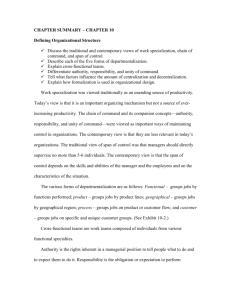

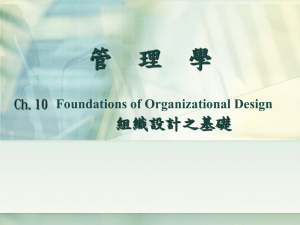
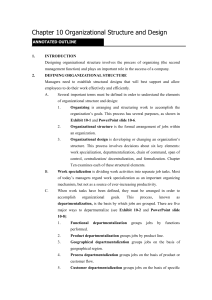
![[SUMMARY] Manajemen (Chapter 10)](http://s3.studylib.net/store/data/008743248_1-4e2b946756cf43cea567b50ee8fe6208-300x300.png)
